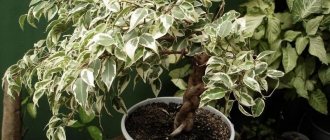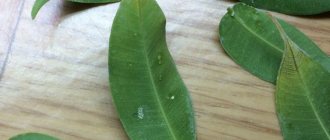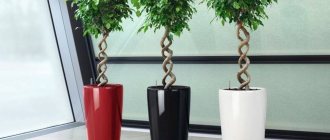Ficus Benjamina is considered the most popular representative of the Ficus genus, used for landscaping in residential buildings, offices, cafes and shopping centers. Just like Crassula or Zamioculcas, Benjamin's ficus is a symbol of wealth and prosperity. Just like Chlorophytum or indoor Geranium, this plant purifies indoor air from dust and toxic compounds emitted by plastic objects and home furniture. In addition, this beautiful plant is not at all difficult to grow at home. We recommend that novice gardeners pay attention to this flower. In this article we will introduce you to the most popular types of indoor flower - ficus benjamina.
Description
Since ancient times, Australia has been considered the ancestral home of the ficus; today, the ficus has actively spread throughout America, Africa, Asia and India. In Russia it is found on the Black Sea coast and in the Krasnodar region. An evergreen tree or shrub that grows up to 25 m in height in the wild.
Ficus benjamina
Ficus Benjamina, one of the most popular species of evergreen plants. The indoor tree has medium-sized emerald foliage and an erect trunk, sometimes taking on a bizarre shape, in the form of an interweaving of several large shoots, cascading branches, and a bright green lush crown.
The leaf of Ficus Benjamin is smooth, pointed, elliptical in shape, richly green in color or with variegated patches. On average, a ficus leaf grows to 8-9 cm. The branches are flexible, covered with gray, thin bark. With proper care, the plant reaches one and a half meters in height.
A special feature of Ficus Benjamin is its capricious nature.
A tree can easily shed its leaves for no apparent reason, due to the slightest lack of nutrients in the soil, or due to climate change in the room. However, you should not be upset, and “the devil is not as terrible as he is painted,” a couple of fertilizing is enough and the tree will turn green again.
General information
Benjamin's ficuses are incredibly popular among lovers of indoor floriculture, masters of phytodesign and interior landscaping. Proper care contributes to Benjamin's fairly rapid growth. The plant can reach a height of two or more meters.
The most popular among gardeners are the following types and varieties of ficus:
- Ficus Danielle;
- Ficus Exotica;
- Ficus Monique;
- Ficus Barok;
- variegated ficus Starlight;
- variegated ficus Reginald;
- small-leaved ficus Natasja;
- small-leaved ficus Kinky;
- small-leaved ficus Wiandi.
Popular ficus varieties
There are several varieties of Ficus Benjamin, each of them has a special appearance.
Variety Exotic
Exotic
This is a compact and unpretentious plant with dark green leaves with wavy edges. It is recommended to start getting acquainted with Ficus Benjamin with this variety due to its unpretentiousness.
Variety Danielle
Daniel
Very similar to the exotic variety. Its leaves are quite large (6 cm) and dark green.
Variety Monique
Golden Monique
A very common variety, which is divided into two similar types: simply Monique and Golden Monique, the leaves of which are characterized by a golden hue. This variety is more capricious than Daniel and Exotica.
Variety Reginald
Reginald
This is the most popular variety and is highly valued for its variegated leaf color. Small light green spots are randomly scattered on a light green background. The edges of the leaves are smooth, not wavy.
Variety Kinkye
Kinky
The color of the leaves is characterized by a combination of a dark green background and a light green edging. The leaves are quite small, not exceeding 5 cm. It is this variety that often needs pruning and shaping. You can create a fancy figure from it.
Variety Nicole
Nicole
Winner for uniqueness of pattern. The light green edging here is much wider than Kinki's. This contrast of dark and light shades looks attractive.
Variety Starlight
Starlight
The leaves of this plant are almost completely white, it looks very impressive. Due to a lack of chlorophyll, the plant needs intense lighting.
Barok variety
Baroque
Its small leaves curl in a funny way, which gives the plant a very unusual appearance.
Among this variety, it is not easy to choose exactly the ficus Benjamin variety that will become your new best friend. It is recommended to prepare for the purchase, learn as much as possible about the characteristics and requirements of the type you like in appearance. A healthy and happy ficus will not only decorate the room, but also purify the air, filling it with useful substances!
How to care for ficus benjamina
In order for this plant to be healthy, pleased with its glossy leaves and grow quickly, it is necessary to follow some rules of care.
Lighting
Ficus benjamina loves bright, diffused lighting; it looks best on western and eastern windows. If possible, take the plant outside or onto the balcony during spring/summer. Fresh air and plenty of light will definitely benefit the ficus. It will fluff up and accelerate its growth. However, it is better to shade it from direct sunlight, otherwise burns will appear on the leaves.
The variegated (variegated) varieties of Ficus Benjamin are especially demanding when it comes to lighting. With a lack of light, they lose their originality, their foliage becomes ordinary, green.
A caveat should be made here. Ficus benjamina can tolerate poor lighting for some time. That is, it can easily stand in your place somewhere in a dark corner for several months. It will not die, but some of the leaves will lose and their color will become dull. That is, as a necessary measure, temporarily, you can place the ficus in a place with insufficient lighting. But it cannot be placed there on a permanent basis.
Temperature
Ideal temperatures for Ficus Benjamin are 16-24° C. But deviations from this range by 4-5 degrees in one direction or another will not cause any particular harm. Try not to let the temperature drop below 10° C, otherwise the ficus will most likely begin to lose leaves. Not necessarily though. If your plant is acclimatized and hardened, then there may not be any negative effects even if the temperature drops to 5° C.
Note! In winter, protect Ficus Benjamin from drafts. Make sure that it does not blow from an open window if it is frosty outside. Almost certainly, after frostbite, the ficus will drop all its leaves. And it will grow them again only in the spring. Best case scenario. At worst, the plant may die.
Watering and humidity
It is necessary to water Ficus Benjamina at home sparingly, since excessive soil moisture often leads to rotting of the root system. Between waterings, the soil in the pot should dry out by 1-2 cm. In winter, more drastic drying can be allowed.
For irrigation, use only warm, settled or boiled water. And this is a very important condition. Ficus benjamina is very sensitive to chemical impurities that tap water contains, such as chlorine and fluoride. Therefore, it is necessary to either settle the irrigation water (at least 8 hours) or boil it.
Spraying
Another important parameter for the health of Ficus Benjamin is high air humidity. In summer and when central heating is on, regularly spray its leaves with warm water. In autumn, on cold days, when the heating is not working or is not turned on at full power, spraying should be avoided.
Note! In winter, do not place Ficus Benjamin near radiators. Too dry air causes leaves to fall.
Top dressing
In the spring-summer period (from March to September inclusive), the Benjamin ficus enters a phase of active growth: foliage grows and young shoots appear. All this requires nutrition, which may not be enough in the soil. Therefore, to ensure full development of the ficus at this time, feed it with fertilizer with a high nitrogen content every 1-2 weeks. In stores, such fertilizers are usually sold with the note “for decorative deciduous plants.” There are also fertilizers specially designed for ficus, for example, Agricola - “For ficus” with a ratio of 23:10:16 (N:P:K).
Note! Root fertilizers are applied in moist soil. That is, first you water the plant with clean, settled water, and after 15-20 minutes - with water with diluted fertilizer. This approach will reduce the risk of chemical burns to the roots.
In autumn and winter, Ficus Benjamin, growing at home, does not need to be fed, since all vital processes slow down during this period. The plants enter a resting stage.
Humidity and watering
Watering alone cannot provide the plant with the necessary moisture. A tropical crop that grows in conditions of high humidity does not tolerate dry air. Ficus needs to be sprayed regularly; you can use a household humidifier. The leaves should be clean and free from dust.
In the warm season and with increased heating, spraying is carried out daily, in the cold season - a little less often. Sometimes you can add 1 aspirin tablet per 1 glass of water to the water for spraying. The water should be settled and at room temperature.
Occasionally it is permissible to give the plant a tropical downpour. To do this, the pot is placed in a bathtub, the soil is covered with a film, and the plant itself “takes a shower” with warm water. A low-growing plant can be dipped with its crown in a basin of water. After some time, the ficus will go to its place.
Drying out the soil is also unacceptable, as is constant dry air. On sunny days, the plant is watered more abundantly, on average 2-4 times a week; in cloudy weather and when the air temperature drops, less often. The flower requires watering if the top layer of soil in the pot has dried out by 2-3 cm.
Overwatering leads to the shedding of leaves and death of the bush.
How to prune ficus benjamina
An important component of ficus care is its pruning. The growth rate of young shoots and branches is high; without pruning, the tree takes on a sloppy appearance, stretches upward and does not bush. Pruning is carried out in early spring, and in summer they only regulate the growth rate of individual shoots that stand out from the general mass.
Pruning allows you not only to control the development of the plant, but also to establish important air exchange in the crown of the tree, eliminate diseased or damaged parts, and prevent pest attacks and the development of diseases.
The branches are cut with sharp pruning shears, without cutting off more than 35% of the ficus crown at a time, otherwise the plant may get sick. In addition, large sections should be sprinkled with ash or crushed coal.
In most cases, the ficus is given the shape of an upright tree with a lush cap, but if desired, the plant can be given an extraordinary, bizarre shape; for this it is necessary to intertwine the trunks of several young plants and carefully secure them with plastic clamps, without interfering with the development of parallel trunks. As they grow, the trees will change, acquiring an unusual wicker shape of a single trunk, and after a few years they will completely grow together.
To ensure that the tree takes on even more fun shapes when pruning, we recommend watching a video on turning a ficus into a bonsai and being patient.
Crown formation and other beauties
With the help of pruning, pinching, interweaving trunks and branches, the plant easily acquires a varied appearance.
There are several of the most common types of crown formation of Ficus Benjamin, among them:
- spherical and dome-shaped crown;
- single- and multi-tiered standard;
- bonsai;
- various sculptures.
It is best to shape the appearance of the tree in the spring. It is worth knowing that it is easiest to form a young plant, as it has more active and rapid growth.
Thanks to pruning, dormant buds are awakened, from which new shoots grow and the tree becomes more magnificent. Also, with the help of pruning, you can improve the appearance of a very overgrown and unattractive-looking plant.
Before pruning, the pruning shears must be disinfected with a weak solution of potassium permanganate and alcohol.
The main bush in the ficus being trimmed is determined; it cannot be cut more than 20 cm, leaving less than 5 leaves, but the side branches are pruned according to desire and creative need. After trimming, the sections must be processed using crushed coal.
When pruning, it is important to adhere to several rules:
- preserving the natural appearance; before pruning, it is worth imagining what the plant will look like;
- cutting at an angle;
- no damage to the bark, breaks or curling of leaves;
- sterility.
If you want to grow a ficus as a standard tree, remove all the side shoots except the top five.
The height of the formation of the bole is determined depending on the placement; if the flower is on the floor, then it is formed at a level of about a meter; if it is tabletop, then this figure is reduced to 40 cm. If you want to get a multi-level bole, set about 5 shoots every 30-50 cm.
Ficus with intertwined trunks also looks very decorative. To do this, several plants are planted in one pot and, as they grow, the trunks are twisted into a rope, braided, or in other forms.
Ficus benjamina: transplant
It is best to transplant Ficus Benjamin at home in March or April. Young specimens need replanting annually, and adults – once every three to four years. In between, remove the top layer of substrate from the pot and replace it with fresh one.
Replant your ficus as follows:
- Take the flower out of the old pot with a lump of earth and, using the transfer method, place it in the center of the new pot, where a layer of drainage and a layer of new substrate have already been laid.
- Fill the voids between the plant and the walls of the pot with soil, shaking the pot slightly. If the room is hot, lightly water the transplanted ficus and spray its crown with a fine spray bottle.
- If the room is cool, it is better not to water the transplanted plant for a couple of days.
- Young Ficus Benjamin bushes should be checked frequently for rapid root growth. To do this, turn the pot over and look at its bottom.
The roots may already be peeking out of the drainage holes. If so, rejoice, you got a fast-growing specimen. Without waiting until next spring, you will have to transplant it into a new, slightly larger pot.
Ficus pot
Choose a clay or ceramic pot for ficus benjamina. The new pot should not be too bulky, just a little larger than the old one. Then the root system of the flower will quickly cope with the development of the entire volume of new soil, and the flower will more easily take root in the new place. Let us immediately pay attention to the size of the pot for creating ficus bonsai - it should be wide and shallow.
What kind of soil should it be?
The natural habitat of Ficus Benjamin is the humid tropics with their characteristic moisture-absorbing nutritious soil.
When growing indoors, you need to buy or prepare a substrate yourself that is similar to its natural composition.
For Ficus Benjamin, purchased soil for decorative foliage plants is suitable. You can use the soil for Mulberry plants or Palm trees.
Note that ficus plants are not very picky about the composition of the soil. It is only important that it is nutritious, breathable and has neutral acidity.
Self-prepared soil should be like this: a mixture of peat, garden soil and sand in equal parts. You can add a little wood ash to eliminate the acidity of the soil. Adult specimens require a denser substrate, so turf soil and humus should be added to this soil composition.
Do not forget! At the bottom of the pot there should be a good layer of expanded clay or other drainage material with the addition of pieces of charcoal.
How to propagate ficus benjamina
There are three options for propagating this plant.
Propagation by cuttings
- For these purposes, they usually take a semi-lignified cutting, not too young, but not very mature either. It is cut with a sharp knife, and does not come off.
- The milky juice that appears on the cut must be washed off.
- To speed up the appearance of roots, it is recommended to cut the base of the cutting.
- The cutting takes root successfully in water, usually in 1-2 weeks.
- To create a greenhouse effect, a larger glass jar is sometimes placed above the jar with the cuttings.
- When the roots have appeared, the cutting is planted in the soil and covered with polyethylene.
Ficus benjamina cuttings
Reproduction by layering
To obtain layering, a ring-shaped cut is made on the lignified stem, then the bark is removed and this area is wrapped with damp sphagnum moss and polyethylene on top. Over time, roots will appear through this coating. Then the top is cut off and placed in prepared soil.
Growing ficus benjamina from seeds
Some gardeners soak the seeds in water for 1 day before planting, but this procedure is not necessary. Seeds are sown in moist soil consisting of sand and peat. They need to be evenly distributed over the surface and immersed 0.5 cm. To ensure heating, the container with the seeds is placed on the radiator if it is heating up. It is necessary to regularly ventilate and spray the seeds. After 1-2 months, the seeds produce their first shoots.
Among all these methods, the easiest and most effective is propagation by cuttings.
Reproduction
It is quite easy to propagate Ficus benjamina at home. To do this, just cut off a small branch and root it in water, and then plant it in the substrate. You can also use the layering method, and enthusiasts can try to grow beautiful and rare varieties from seeds.
Cuttings
Cuttings are the easiest and fastest way to get a new bush. To do this, separate a twig 8-10 cm long. It is advisable to choose not young green twigs, but semi-lignified ones. Drops of milky juice are removed from the cutting site, the cuttings are placed in a glass of water and covered with a transparent cap. As a rule, after 1-2 weeks the first roots will begin to appear. When they grow to 5 cm, the seedlings are planted in a pot with substrate.
By layering
A small circular cut is made on a bare branch, wrapped in damp moss, and covered with a transparent film on top. The film is secured at the top and bottom with thread or soft wire. From time to time you need to moisten the moss; to do this, open the film from above and drop a couple of drops of water under it. As roots begin to appear on the stem, the branch is cut off and rooted in a pot with substrate.
Seeds
New varieties of Ficus benjamina can be grown from seeds. To do this, the material is pre-soaked for a day in warm water, then sown in a peat-sand mixture. The seeds are planted to a depth of 0.5 cm, sprinkled with earth, covered with film and placed in a warm, bright place. For germination, seeds are kept at a temperature of +25-+270C. The film is removed daily for 10-15 minutes, the greenhouse is ventilated and, if necessary, the surface of the substrate is moistened with a spray bottle. When the first shoots appear on the soil surface, the film is removed. The seeds may take about 2-3 months to germinate, so you need to be patient. After the seedlings hatch and grow a few leaves of their own, they are transplanted into small pots with suitable soil.
Diseases and pests
When growing Ficus Benjamin, the following problems may arise:
- The lower leaves fall off. Sometimes this is a natural process as the ficus matures, and sometimes it is a sign of hypothermia and insufficient lighting.
- Ficus benjamina leaves wither and curl. The plant is cold and suffers from low temperatures.
- The tips of the leaves turn brown. The humidity level is very low and the indoor air is dry.
- New shoots are thin. The plant lacks lighting and nutrition.
- The leaves of Ficus Benjamin are turning yellow. The plant is subjected to too intense watering, its root system begins to rot.
- The leaves are soft. Another sign of flower hypothermia.
- Yellow and brown spots on leaves. This is how sunburn appears on the surface of the leaves. The plant is exposed to excessive solar radiation.
Spots on ficus benjamina
Ficus can also become a victim of the following pests:
- mealybug;
- scale insect;
- spider mite
- White lumps at the base of the leaves may indicate a mealybug problem. This pest has a small body, as if covered with cotton wool. How to deal with mealybugs on Ficus benjamina: Remove white spots on the leaves of Ficus benjamina using a soft sponge soaked in a soapy solution. Treat all parts of the plant with soapy water. Treat with insecticide. After this, you can trim the bush, and when it is completely restored, then spray it with epin or succinic acid.
- Sticky leaves indicate a scale infestation. A related problem may be sooty fungus, which is very fond of the sweet secretions of this pest. The infected plant is washed with soapy water and treated with Actellik.
- Spider mites on Ficus benjamina appear in dry indoor air. The infected plant does not grow, begins to wither, turns yellow and drops its leaves. The first thing to do when you find cobwebs on your Ficus benjamina is to increase the humidity in the room. To do this, install a humidifier, vessels with water nearby, or sprinkle with water mist. Spraying with a soap solution, Aktara or Aktellik will help get rid of pest colonies. Afterwards, the bush is covered with a transparent cap or bag and ventilated daily.
Growing problems
Why do the leaves fall and turn yellow?
The biggest problem in growing ficus is leaf falling, sometimes massively. During the winter, the plant loses a lot of leaves, sometimes becoming almost completely exposed. We need to figure out why ficus leaves fall off and turn yellow.
Ficus leaf fall is a natural process. This is how the plant reacts to stressful situations. In winter it is:
- lack of light;
- dry air associated with central heating;
- air temperature is too high.
Falling leaves from spring to autumn can be caused by overgrowth of the root ball or excessive drafts. During the growing season, the problem can be eliminated, and in winter the “losses” can be reduced.
Common causes of leaf falling:
- Inappropriate position. Too little or too much light. Ficus grows best in sunny places; it needs plenty of diffused light all year round. The shoots lose their leaves if the pot is placed too far from a window or in direct sunlight. The plant does not like to be moved, but in winter you can break this rule and move the pot to a sunny windowsill (if it fits). Moving large pots a little closer to the window doesn't make much sense.
- Unsuitable soil. If the ficus grows in too peaty soil, it dries out on top, while the lower part is still wet. Therefore, watering is carried out more often than necessary, resulting in flooding of the plant. It is necessary to transplant the ficus into suitable soil, removing areas of the substrate in which rotten, damaged roots are present. After transplantation, watering begins 6 days later in small doses. The roots should begin to assimilate water.
- Moving. Changing the location, growing conditions, replanting, moving the pot causes severe stress on the plant and leaves fall off. The permanent place where this indoor plant is grown should be quiet and calm.
- Too wet or too dry. An improperly watered ficus quickly shows dissatisfaction. If the leaves dry out and fall off en masse, it is a sign of a lack of water. If they turn yellow before falling off, overwatering has occurred, so if the lower leaves begin to fall off, stop watering the plant immediately. The plant needs to be watered regularly to keep the substrate slightly moist at all times. It is advisable to use boiled, settled water. It is necessary to make drainage holes at the bottom of the pot; it is worth using a drainage layer (expanded clay).
- Insufficient air humidity causes leaves to dry out. First, the tips of the leaf blade wither, then turn yellow, turn brown, and dry out. You can place a humidifier or trays of water nearby and regularly spray the leaves with a spray bottle.
- Too cold or too hot. During the growing season (from spring to late summer), ficus grows well at normal room temperature. For the autumn-winter period, it is worth providing a slightly lower temperature (10-18 degrees C). It is better not to place the pot next to a radiator or in a draft. Too high a room temperature during the dormant period (winter) is a common cause of yellowing leaves (usually caused by central heating).
- Avoid breaking off yellow leaves that remain on the plant - this often speeds up defoliation.
- The causes of yellowing leaves may be the diseases and pests described below. Diseases (rot and mold) appear more often with abundant watering. Using appropriate protection products can save the plant.
What else can you do:
- From autumn to spring we refuse any fertilizers.
- In winter, the plant should be watered much less frequently, preferably with boiled water.
- If possible, keep the temperature as low as possible.
- We combat dry air by regularly spraying the plant.
- Prune the plant (in autumn), shortening shoots and removing thin, weak, unnecessary branches. Ficus lends itself well to pruning and shaping.
- Ficus cleanses the air of harmful compounds, but does not like tobacco smoke - therefore it should not be placed in rooms where people smoke. Also in the kitchen, the plant may suffer from the action of gas stoves.
Attention! It is worth working with gloves and being careful not to get the milky juice on your skin, which can cause a mild skin allergy.
Diseases
When purchasing ficus, you should choose healthy plants with clean foliage and no pests. You need to carefully examine the selected specimen, pay attention to the substrate to see if insects are swarming there. It is worth choosing younger ficuses, they adapt more easily to the conditions of the apartment.
Ficus is characterized by fairly significant disease resistance, but the plant is sometimes affected by certain microorganisms:
- Ficus leaf spot - a disease that appears when the plant does not have access to the right amount of light. Yellow spots appear on the leaves. An aggravating factor in the development of the disease is high air humidity. It is worth placing the ficus closer to the window.
- Root rot - inadequate care can lead to the development of fungal disease of the roots. Yellowing and then falling leaves may indicate a situation has arisen. The disease develops if the plant does not have adequate permeable substrate and is watered frequently.
- Powdery mildew appears as spots on the leaves, white discoloration appears over the entire surface, the leaf becomes transparent in the affected areas, turns yellow, and falls off. Do not water too often, do not spray the leaves with water. You can treat it with environmentally friendly preparations for powdery mildew; treating it with pesticides in an apartment is dangerous to your health.
Photo. Symptoms of powdery mildew on ficus leaves
Fungal diseases are difficult to eliminate. Proper care after a plant infection is not always a sufficient solution. Sometimes you will have to turn to appropriate drugs against fungal pathogens - fungicides.
It is important not to use fungicides in residential areas to avoid harm to people and pets.
Ficus benjamina leaves are falling: what to do
Ficus benjamina sheds its leaves for various reasons such as:
- sudden changes in temperature;
- drafts;
- low humidity levels;
- excessive or insufficient watering;
- low air temperature;
- insufficient fertilizers;
- change of location;
- watering with cold water;
- insufficient lighting.
If the tree is healthy, after eliminating the main cause that caused the leaves to fall, they begin to grow back immediately.
What to do if all the leaves have fallen off?
If this does happen, the following actions must be taken: eliminate all negative factors in the room that have a detrimental effect on the ficus.
- Check the temperature and humidity.
- Eliminate drafts and nearby heat sources.
- Do not move the pot with the plant.
- Check the soil and plant roots.
- Make sure there is sufficient lighting level.
Briefly about care
Temperature in summer +18º - +25º, in winter from +16º Air humidity is high Lighting is moderately bright, diffused Where to put the eastern, south-eastern, western, south-western, southern window sill Watering in summer 2 times a week, in winter - 1 time a week soil with sand and coal Feeding and fertilizing once every 14 days from spring to autumn with organic and mineral preparations Replanting annually in spring Propagation by cuttings, layering, seeds
Ficus Benjamin: signs and superstitions
There are many superstitions associated with Ficus Benjamin. If in the East this plant is considered to be a symbol of wealth and prosperity, then in Russia and the CIS countries the ficus is called “muzhegon” and is credited with magical properties that have a negative impact on family members.
In China, Ficus Benjamin is given as a wedding gift and passed on from one generation to another, and in some Eastern countries this beautiful tree is considered sacred. At home, ficus is able to absorb negative energy, attract wealth into the house and help in amorous matters. If you give Ficus Benjamin to a childless couple, they will soon have a child.
But in order for this tree to have a positive effect on the “weather in the house”, it must be placed correctly:
- Kitchen - wealth and relief from financial problems.
- Office - good luck at work and increased productivity.
- Bedroom – improved sleep, relief from anxiety and quick pregnancy.
You should not place a pot of Ficus benjamina on the north or west side of the house. Then the plant will not have enough sun, and it will not be able to influence the microclimate in the family.
Everyone decides for himself whether to believe or not to believe in various superstitions. But in any case, if this beautiful and lush tree appears in the house, the room immediately transforms and becomes more comfortable.
Choosing a growing position
This plant needs quite specific conditions. If you provide them, caring for your ficus will be much easier, and falling leaves and other diseases will not bother you.
The ficus pot should be placed in a place where the temperature is 20-24 degrees Celsius; it cannot be grown on the balcony or in the garden.
The minimum air temperature in the apartment should not fall below 13 degrees Celsius. In summer, the maximum temperature should be 24 °C. Sometimes the temperature can exceed 25 °C, but the main thing is to protect the plant from the scorching rays of the sun. It is also important to avoid drafts.
Ficus is harmed by dry air, so it is worth increasing the humidity, especially in winter, when problems arise under the influence of central heating.
The most important condition for ficus is the correct intensity of sunlight. Ficus benjamina has very high requirements in this regard. It loves the sun, it needs a lot of light, otherwise there is a risk of leaves falling off. But the plant does not need direct sunlight; it is better to place it at a short distance from the window.
The ficus gets used to the angle of light, so you can’t move or rotate the pot. Even a slight displacement slows down the growth of shoots and leaves and causes numerous problems in growing. It is worth making a sign on the pot indicating how the pot is placed relative to the window. The position of the plant must be carefully considered for 2 reasons:
- it should not be rearranged;
- The ficus is quite large and will need a lot of space in a few years.
Advice. Ficus is very sensitive to sudden changes in temperature; when buying a flower in the cold season, it is worth wrapping it in paper during transportation. Too long a trip or lack of light can cause the plant to start losing leaves once it gets home.
Interesting Facts
- Ficus benjamina is the symbol tree of Bangkok, the capital of Thailand.
- Often, to give thickness and texture to the trunk of a plant when grown for decorative purposes, 2-3 plants are planted together and their trunks are woven into a braid or strand. As they grow, the trunks grow together and form beautiful growths.
- In the Royal Botanical Gardens in Peradeniya, Sri Lanka, there is a ficus tree that is 150 years old and has a crown area of 25 square meters. Local residents gave it the name “Turtle” due to the similarity of the crown shape with this animal
Sources and literature











